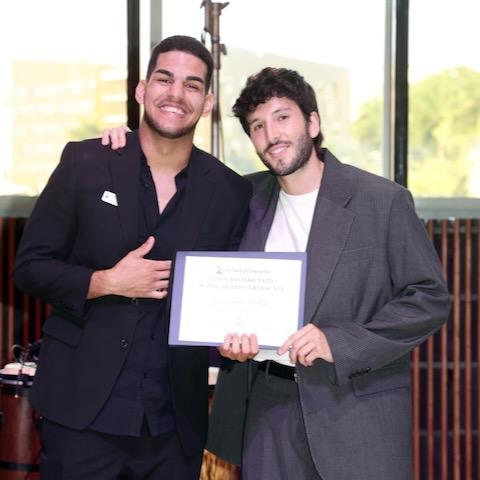Harry Gregson-Williams on Making and Remaking the Shrek Theme

Composer Harry Gregson-Williams broke down moments from his score to Shrek and several other blockbuster films.
Image by Ben Pu
Harry Gregson-Williams is an extremely busy man. The esteemed film composer has scored more than 100 films, plus acclaimed television shows and video games. But this week he took a day out of his normal work schedule to join Berklee students and faculty for the college's annual BMI Day. As part of his visit, Gregson-Williams spoke to a packed Red Room at Cafe 939 on Monday afternoon, and broke down the process behind some of his most recognizable and innovative scores—including the Shrek films, The Martian, and Man on Fire. Below are just a few key takeaways from Gregson-Williams’ career-spanning lecture.
On Shrek’s Shapeshifting “Fairytale” Theme
Gregson-Williams went in-depth on his approach, over the course of numerous films and scenes, to transforming the opening “Fairytale” theme from Shrek into music fit for a storybook, an award show, a power-rock pump-up scene, a tinny record player, and a tragic apparent death scene. "I found out that I was going to have to mess with that theme quite a lot,” he said. Much of what made the transformations work, he explained, was “all about timing.” By transforming the original theme's lilting waltz into a chugging four-count rock riff, the whole feel of the melody changes.
Changing the instrumentation and introducing novel countermelodies were equally important factors in modifying the underlying musical mood to fit each scene. “[Countermelody] is hugely important in all the music that I write…because if I weren’t bothered with contrary motion and countermelody, my music would be really blocky…they’re very straightforward, the melodies that I’m using."
On Self-Understanding and Connecting with an Audience
"I know what I’m not necessarily outstanding at, and I’ve understood what I could be reasonably good at through hard work. I’m no Mozart. I could write a little tune, a little nugget—but it’s really what I’m going to do with that nugget that’s important,” Gregson-Williams said. He encouraged the students in the room to “latch onto something that means something to you... It could be just three chords. [He plays three chords.] They’re not mine—they’ve been used a million times before, probably in that order and rhythm. But we have to find something that we take ownership of—something that really moves us—because then, I think, we have a chance of moving others with our music.”
On Making Mistakes and Owning Them
Gregson-Williams told the story of how, as he was writing an important cue for The Martian, he became very inspired by Pink Floyd’s Dark Side of the Moon (“I mean, if you’re going to make a movie called The Martian...” he joked), and wanted the cue to share some of that album’s epic guitar work and drumming style. It didn’t work. While the music was well executed, the progressive rock style didn’t fit with the rest of the scene, and he was asked to rewrite the cue. “Sometimes, you can be wrong, and you’ve really got to own it,” he said. And he did own it, playing the original cue right after the final cut to show how the idea developed from this earlier attempt.
"We have to find something that we take ownership of—something that really moves us—because then, I think, we have a chance of moving others with our music."
-Harry Gregson-Williams
On Adding Some Light to Dark Music
“I’ve found that in order to show darkness, one’s got to be able to show a little bit of light,” Gregson-Williams explained, saying that when writing a cue that’s heavy or grave, “most of us will go to our left hand [on the keyboard], go nice and low,” however, “often, when one’s trying to show darkness, there may be an element—a color—that one can display as lightness. It’s a bit like a tuning fork; you can gauge how dark something is by the light of something else."




